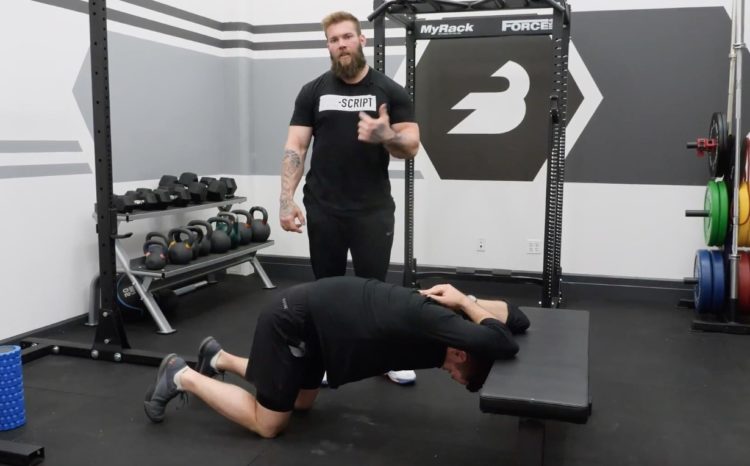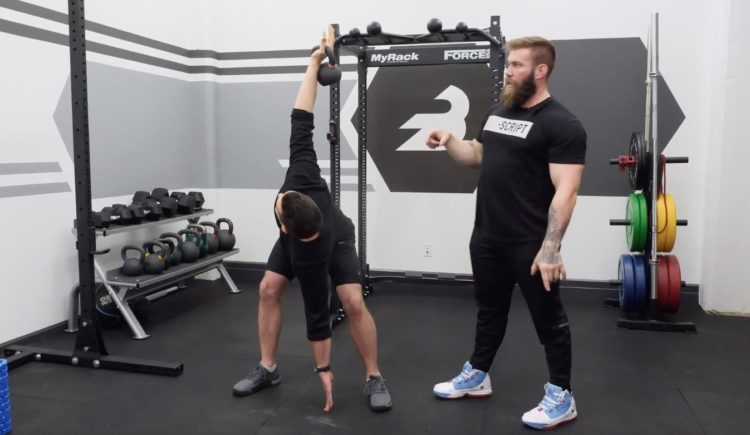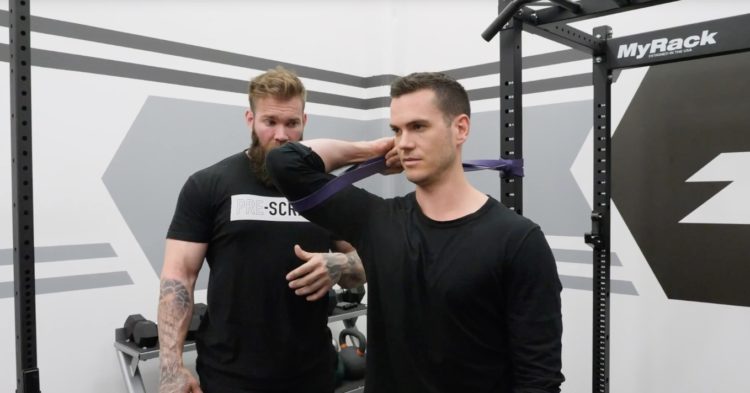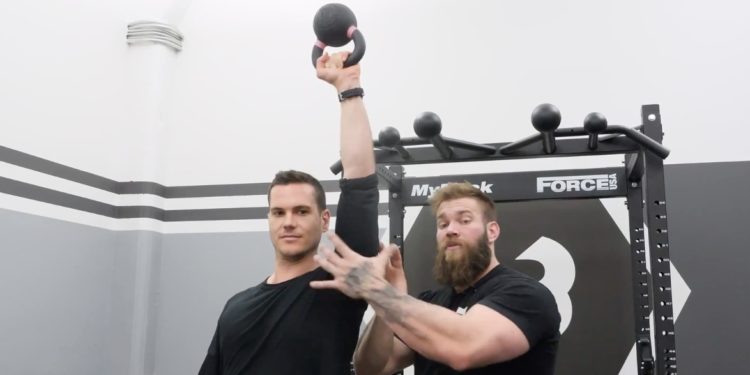The rotator cuff is a group of muscles and tendons that help to maintain shoulder health and stability.
Contrary to popular belief, you don’t want a strong rotator cuff, you want a stable rotator cuff that can resist force.
Injuries are most frequent among those who repeatedly perform overhead movements at work (this writer experienced one shelving sweaters in a warehouse) or in sports (like in Olympic weightlifting and standard strength training).
Rotator cuff injuries (or the fear thereof) are tremendously common among the strong, so we recruited competitive powerlifter and strength coach Jordan Shallow, who founded Pre-Script in order to help athletes prevent injuries before they even happen.
He came up with these four movements that address the functional subcomponents of the shoulder, so they all work in concert to improve rotator cuff performance. Shallow suggests performing them as a circuit — run through the movements three to five times before a shoulder workout and you’ll be on your way to healthier shoulders.
Editor’s note: The content on BarBend is meant to be informative in nature, but it shouldn’t take the place of advice and/or supervision from a medical professional. The opinions and articles on this site are not intended for use as diagnosis, prevention, and/or treatment of health problems. Speak with your physician if you have any concerns.
1. Thoracic Spine Extension
Body part: Thoracic spine
Reps: Static stretch, 20 – 30 seconds
The thoracic spine runs from the base of the neck to the bottom of the ribcage — it’s not the upper or the lower back — and it’s often overlooked when it comes to an athlete’s mobility. But the thoracic spine is often what takes a hit from the sedentary, seated, hunched over lifestyle.
“Increasing our ability to extend our thoracic spine will directly dictate how well we can use the rotator cuff at the end,” says Shallow.
Here’s a simple, static hold you can perform on any bench.
- Put the elbows on bench a little wider than shoulder width apart.
- Drop the head below the plane of the bench.
- Flex the elbows backward, placing the hands on the upper back.
- Keep the ribcage tucked to help the upper back extend and keep the lower back from bending too much.
- Hold for 20 to 30 seconds.
This helps the torso get out of the rounded position and open up the back so the scapula can move better.
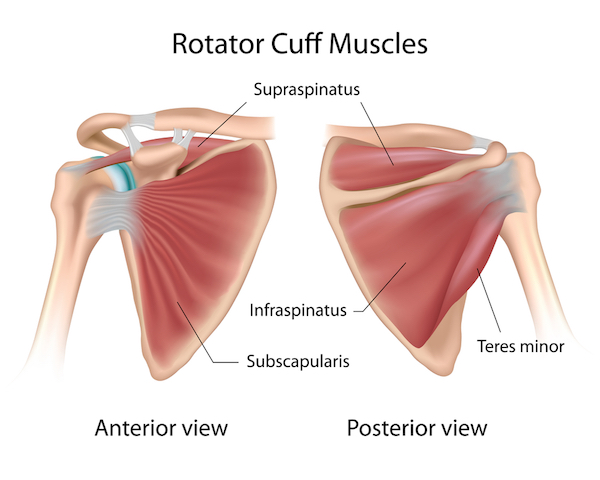
[Related: 4 movements to improve thoracic mobility]

2. Kettlebell Windmill
Body part: Scapula
Reps: 6-8 per side
The scapulae is the correct term for the shoulder blades, which help to the shoulder to rotate, plus they take pressure of the chest muscles. The kettlebell windmill is a tricky movement that introduces a medium of instability to the scapulae while also extending and rotating the thoracic spine.
- Hold a kettlebell straight up overhead, with the elbow pointing in front of you so the palm is facing inward and the pinkie forward.
- Stand with the feet slightly wider than shoulder width.
- Rather than bending over sideways, push the hips back while rotating and extending the thoracic spine and bringing the non-kettlebell hand to the floor between the feet.
- The palm is now facing the other side of the room.
- Before returning to standing, really push the arm holding the kettlebell upward. This flexes the serratus, a muscle that spans over the ribs and improves the safety of shoulder movements.
This movement is a little complicated, so feel free to check out our complete guide to the kettlebell windmill.
[Related: 10 movements for strong, healthy scaps]
3. Overhead Band Stretch
Body part: Lats
Reps: 6 – 9, holding for 6 – 8 seconds
The lats are an under-addressed muscle when it comes to the shoulder. Because they’re opposed to the pecs, most people think they have an opposite function — simply pulling — but in fact, they attach to the spine (the pecs don’t) and the lats are one of our strongest internal rotators. You don’t want the shoulder to rotate internally during your overhead workouts, so this movement helps to stretch and activate the lats the right way and minimize the internal rotation.
- Anchor a resistance band beneath the elbow, grasping it with the palm.
- Lunge forward with the opposite leg.
- Keep the rib cage down to minimize extension of the lower back.
- Push into the resistance of the band, activating the lat and its active shoulder extension.
- After 6 to 8 seconds of holding contraction, slowly let the tension win and pull the arm back upright.
- Perform for reps.
[Learn more: Fight collapsing elbows with these 6 lat mobility drills]
4. Kettlebell Bottoms Up Press
Body part: Rotator cuff
Reps: 6 – 10 per side
Now that we’ve addressed all these three of its subcomponents, it’s time to work the rotator cuff itself. Remember, this group of muscles isn’t about strength, it’s about stability and resisting force, and Shallow’s favorite movement for it is the bottoms up kettlebell press.
- Hold the kettlebell so the weight is suspended over the hand; this requires a very tight grip, which activates the rotator cuff.
- Keep the kettlebell, wrist, and elbow in line with the palm facing inward.
- Press it up overhead, slowly rotating the hand so that it faces the front of the room at the top the movement.
- Keeping the elbow tucked, lower through the eccentric component of the movement.
Remember, don’t go too heavy here. Training stability is a prerequisite for building skill, and you wont build skill if you’re doing heavy singles and doubles. The bottoms up press isn’t something you’re looking to max out, it’s something we’re looking to optimize and adapt to. Eight to twelve reps give you more practice at the skill of being stable in the shoulder.
[Related: 3 bottoms up kettlebell exercises to improve lifting technique]
https://www.instagram.com/p/Bn4Z292ARYR/
Wrapping Up
With this circuit, you’ve put together four pieces of the rotator cuff puzzle and the functional subcomponents of the shoulder, without just honing in on the rotator cuff muscles themselves. This is training intelligently; approach all of your training with this kind of holistic mindset, and you’ll have a lower risk of injuries and a more functional body.
Featured image via @primal.swoledier on Instagram.
